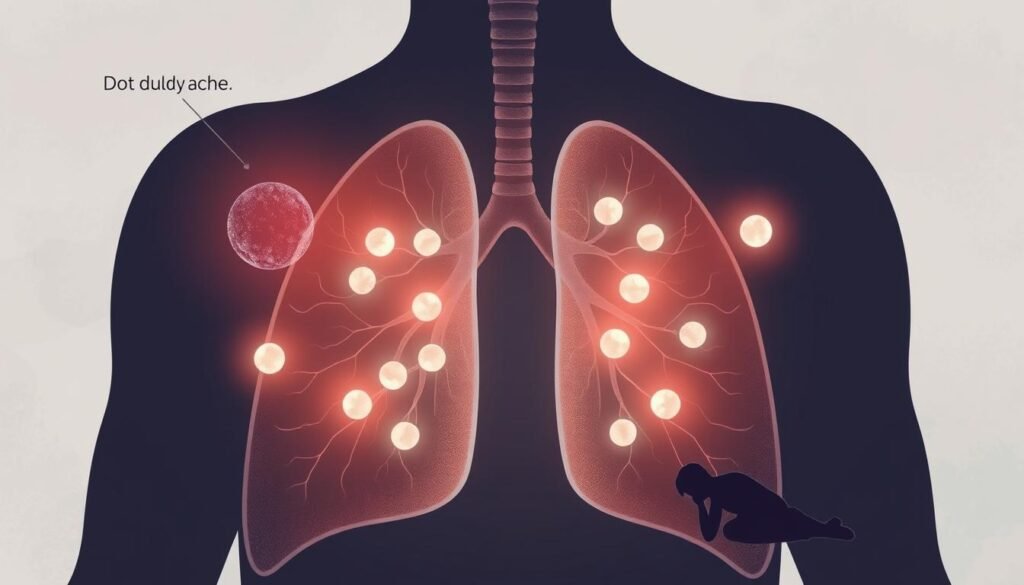It’s quite surprising to know, but non-Hodgkin lymphoma outnumbers Hodgkin lymphoma with about 90% of cases. This fact highlights the rarity but importance of being informed about lymphoma. Especially considering its connection with lung cancer. Lung cancer lymphoma is particularly tricky. It can be hard to tell apart from other lung issues. In this article, we explore lymphoma’s signs, its types, and how it’s treated. It’s all about giving patients the prompt and full care they need.
Key Takeaways
- Non-Hodgkin lymphoma comprises the majority of lymphoma cases.
- Individuals over 65 are particularly at risk for lymphoma diagnosis.
- Common symptoms of lymphoma include painless lymph node swelling, fever, and fatigue.
- Chemotherapy and emerging therapies like immunotherapy are key treatment options.
- Timely diagnosis is essential in determining effective treatment plans.
Understanding Lung Cancer Lymphoma
Lung cancer lymphoma is a special challenge. It combines lung cancer with lymphatic system issues. These problems make symptoms and treatments more complex. The lymphatic system helps fight off illness. So, it’s key in dealing with cancers. Symptoms may look like other lung problems. This makes knowing the difference crucial for good care.
Many symptoms can appear with this kind of cancer. It may confuse doctors trying to spot typical lung cancer. Noticing the subtle differences aids in finding better treatments. Treatments might include chemotherapy or new targeted methods. It all depends on the exact diagnosis.
It’s vital for health experts to grasp lung cancer lymphoma. Here’s a table showing the key differences between lung diseases and their treatments. It highlights how lymphoma behaves differently:
| Type of Malignancy | Characteristics | Treatment Options |
|---|---|---|
| Non-Small Cell Lung Cancer (NSCLC) | Most common type, includes adenocarcinoma, squamous cell carcinoma. | Surgery, chemotherapy, targeted therapy, radiation therapy. |
| Small Cell Lung Cancer (SCLC) | Grows and spreads rapidly, primarily related to smoking. | Chemotherapy, radiation therapy, palliative care. |
| Lymphoma | Can originate in the lungs or spread from other areas; may present as lung cancer. | Chemotherapy, immunotherapy, radiation therapy. |
| Mesothelioma | Rare; primarily associated with asbestos exposure. | Surgery, chemotherapy, radiation therapy. |
This disease is complex. It blends lung cancer and lymphoma traits. Understanding this helps give patients the right care. Every therapy option has its challenges and results. This makes expert knowledge very important.
What is Lymphoma?
Lymphoma is a type of blood cancer that affects the immune system. It targets white blood cells known as lymphocytes, crucial for fighting off infections. To understand lymphoma, it’s important to know about the lymphatic system, which plays a key role in immune function.
Overview of the Lymphatic System
The lymphatic system is key to our health. It produces lymphocytes in organs like the spleen and thymus. This system’s vessels, nodes, and tissues move lymph fluid throughout the body. Lymph nodes can develop tumors if lymphocyte growth becomes abnormal.
How Lymphoma Develops
Lymphoma begins with genetic mutations in lymphocytes. These mutations cause cells to grow uncontrollably, forming tumors often found in lymph nodes. There are two main types of lymphoma: Hodgkin, marked by Reed-Sternberg cells, and non-Hodgkin, which includes a wider range of lymphatic cancers. Factors such as age, weakened immune system, and certain infections can influence lymphoma development. Research advances are boosting treatment and patient outcomes. For more details on lymphoma, check out this informative link.
| Type of Lymphoma | 5-Year Survival Rate | Common Symptoms |
|---|---|---|
| Hodgkin Lymphoma | 88.9% | Swollen lymph nodes, fever, night sweats |
| Non-Hodgkin Lymphoma | 74.3% | Fatigue, unexplained weight loss, chest pain |
Types of Lymphoma
Lymphoma covers various types of blood cancers in the lymphatic system. The main types are Hodgkin lymphoma and non-Hodgkin lymphoma. They have different signs, symptoms, and treatments. It’s crucial to know these differences for the right diagnosis and treatment.
Overview of Hodgkin Lymphoma
Hodgkin lymphoma is marked by Reed-Sternberg cells. It usually starts in lymph nodes in the neck, armpits, or chest. Young adults in their 20s and people over 55 are mostly diagnosed with it. Each year, about 90,000 Americans find out they have lymphoma, with Hodgkin lymphoma being a significant fraction.
Overview of Non-Hodgkin Lymphoma
Non-Hodgkin lymphoma is more common and doesn’t have Reed-Sternberg cells. It’s often seen in those 65 or older. There are many types, including diffuse large B-cell lymphoma and follicular lymphoma. For more details on lymphoma types, check out this resource.
| Type of Lymphoma | Common Characteristics | Typical Age of Diagnosis |
|---|---|---|
| Hodgkin Lymphoma | Presence of Reed-Sternberg cells | 20s and over 55 |
| Diffuse Large B-cell Lymphoma | Most frequently diagnosed non-Hodgkin lymphoma | Older Adults |
| Follicular Lymphoma | Indolent type, slower growth | Middle-aged to older adults |
| Mantle Cell Lymphoma | Affects mostly older men | Older Adults |
| Burkitt Lymphoma | Highly aggressive, often seen in children | Young Adults and Children |
Lung Cancer Lymphoma: Symptoms and Signs
Knowing what signs to look for in lung cancer lymphoma is key. Catching these signs early can lead to better treatment and outcomes. Each person may show different symptoms based on lymphoma type and where it is in the body.
Common Symptoms of Lymphoma
There are several signs that could mean someone has lymphoma. Some of these signs are:
- Swelling in lymph nodes, particularly in the neck, armpits, or groin
- Fatigue that does not improve with rest
- Unexplained weight loss of at least 10% over six months
- Night sweats that soak clothing and bedding
- Itching or skin rashes
Since these symptoms can be like those of other illnesses, it’s important to get checked by a doctor.
B Symptoms: Indicators of Disease Progression
B symptoms can tell us how lymphoma is advancing. Key B symptoms include:
- Drenching night sweats
- Fever without an identifiable cause
- Unexplained weight loss exceeding 10%
Seeing these B symptoms could mean the lymphoma is more serious. It helps in understanding the patient’s overall health outlook.

| Symptom | Type | Significance |
|---|---|---|
| Swollen lymph nodes | Common | Potential indication of lymphoma. |
| Weight loss | B Symptom | Important marker in disease progression. |
| Night sweats | B Symptom | May suggest advanced lymphoma. |
| Fatigue | Common | Need for further evaluation. |
Early detection of lymphoma symptoms is crucial. It can lead to quicker care. Knowing about B symptoms also aids in understanding how severe the disease might be.
Diagnosis of Lung Cancer Lymphoma
To diagnose lung cancer lymphoma, doctors use a mix of exams and tests. Catching the disease early is key for better care. This approach helps doctors decide the best treatment.
Initial Physical Examination
The first check-up is crucial for spotting lymphoma. Doctors look for swollen lymph nodes as a clue. They also check for other signs to understand the patient’s health. This step is vital in starting the diagnosis.
Diagnostic Tests for Lymphoma
After the check-up, if lymphoma seems likely, more tests confirm it. Tests include:
- Biopsies: Taking a tissue sample to look for cancer cells.
- Bone marrow tests: Checking if the cancer has reached the bone marrow.
- Imaging studies: PET or CT scans show how much the cancer has spread.
These tests help doctors fully understand the disease. They can then make a care plan suited to the patient.
Understanding Lung Carcinoma and Its Relation to Lymphoma
Lung carcinoma is a big health issue, mainly known as a type of lung cancer. It primarily affects the lung tissue. It’s important to understand lung carcinoma to see how it’s different from lymphoma. Knowing the differences is key for the right diagnosis and treatment.
What is Lung Carcinoma?
Lung carcinoma, or lung cancer, starts from bad cells in the lung tissue. It mainly comes in two types: small cell lung cancer (SCLC) and non-small cell lung cancer (NSCLC). About 80 to 85 percent of lung cancer is NSCLC. The most common kind of NSCLC is adenocarcinoma, starting in mucus-making cells.
SCLC, making up about 15 to 20 percent of lung cancer, is known for being very aggressive.
Differences Between Lung Carcinoma and Lymphoma
It’s important to know how lung carcinoma and lymphoma are different. Lung carcinoma comes from lung cells, but lymphoma starts in the lymphatic system. These differences affect how they are treated and the patient’s prognosis. For example, primary pulmonary lymphoma is very rare, being less than 1% of all non-Hodgkin’s lymphoma cases.
Lung carcinoma and lymphoma have different symptoms and ways to diagnose them. People with lung carcinoma might have breathing problems, cough, or lose weight. On the other hand, lymphoma patients might see swollen lymph nodes and have fever or night sweats. It’s also common for lymphoma to be diagnosed wrongly at first, leading to delays in treatment.

Stage and Prognosis of Lung Cancer Lymphoma
Lymphoma staging is key to understanding how serious the disease is. It guides the treatment plan. Doctors use it to guess how the disease will go and make treatment just for you.
Staging Lymphoma: What It Means
Lymphoma is split into stages that show how much it has spread. Early-stage lymphoma usually means a better chance of surviving. For example, people with lung cancer that hasn’t spread far have a higher survival rate.
Studies show that survival rates are about 65% for stage 1 lung cancer. But it falls to 5% for stage 4. This shows why finding and treating cancer early is crucial.
Prognosis Factors for Lymphoma Patients
The outlook for lymphoma patients depends on a few things. These include the lymphoma type and stage, the patient’s age, and how the tumor reacts to treatment. Those caught early have a better chance, with about 40% surviving for five years at stage 2.
But the chance of surviving drops to 15% at stage 3. At stage 4, it’s even lower, with a 5% survival rate. However, certain types of lymphoma respond better to treatment. This can greatly improve chances of living longer.
For more information on lung cancer stages, check out the insights on lymphoma staging and prognosis.
Treatment Options for Lung Cancer Lymphoma
When we talk about lung cancer lymphoma, doctors use different strategies. They choose lymphoma treatment options based on the lymphoma type and stage. They also look at what’s unique about the patient. Knowing about the treatment methods is key for the best patient care.
Chemotherapy Approaches
Chemotherapy is often used for lymphoma. It uses strong drugs to kill cancer cells. Your doctor might suggest chemotherapy as an important way to control the cancer and aim for remission.
Targeted Therapies and Immunotherapy
New research has led to targeted therapies. These focus on the cancer cells’ specific genetic changes. Many patients now prefer targeted therapy because it is more exact. Immunotherapy, on the other hand, uses the body’s immune system to fight cancer. This adds more options for patient care.
Importance of Personalized Treatment Plans
Everyone facing lymphoma has a different experience. That’s why doctors create treatment plans that meet each patient’s specific needs. They consider the type of lymphoma, its stage, and the patient’s overall health. This way, they can combine treatments like chemotherapy and targeted therapy most effectively.
| Treatment Type | Purpose | Typical Use |
|---|---|---|
| Chemotherapy | Target and kill cancerous cells | Standard for aggressive lymphomas |
| Targeted Therapy | Disrupt specific cancer cell functions | Used for certain genetic mutations |
| Immunotherapy | Boost the immune response against cancer | Adjuvant therapy in advanced stages |
The Role of Thoracic Oncology in Treatment
Thoracic oncology is key in treating thorax cancers, like lung cancer and lymphoma. Thoracic oncologists’ knowledge greatly improves patient care. They ensure treatments meet each patient’s needs regarding cancer type and stage. This focus betters treatment results and supports new therapy advances.
What Thoracic Oncologists Do
Thoracic oncologists manage cancers in the chest, focusing on lung cancer and lymphoma. They create customized treatment plans. These may include chemotherapy, immunotherapy, surgery, and more. This approach matches the treatment with the cancer’s nature and the patient’s health.
Multidisciplinary Approach to Treatment
A team approach is essential in thoracic oncology care. This includes surgeons, radiologists, and other specialists. They work together to develop detailed treatment plans. For example, teams like at Washington University research new treatments and trials. They target improving outcomes for lung cancers. This teamwork uplifts patient care and helps find new therapy options. For more, visit this link.
| Type of Treatment | Description |
|---|---|
| Chemotherapy | Uses drugs to kill cancer cells or stop them from dividing. |
| Immunotherapy | Boosts the body’s immune response against cancer cells. |
| Targeted Therapy | Targets specific aspects of cancer cells or the surrounding environment. |
| Surgery | Involves the physical removal of tumors. |
| Radiation Therapy | Uses high-energy rays to destroy cancer cells. |
Thoracic oncologists play a crucial role in cancer care. Their expertise and team efforts improve life quality and outcomes for those with thoracic cancers.
Managing Symptoms and Side Effects
It’s vital to handle lymphoma symptoms well to enhance life quality during treatment. Patients often face side effects that disrupt daily life. These effects span physical, emotional, and cognitive areas. Supporting cancer patients helps them deal with their diagnosis and therapy better.
Supportive Care Options
Supportive care aims to lessen symptoms and boost well-being. Key methods include:
- Pain management uses medicine and therapies to fight cancer pain.
- Nutritional support helps keep a healthy diet, aiding those with eating troubles.
- Counseling services offer emotional aid, tackling anxiety, depression, and feeling alone.
- Cognitive care assists with “Chemo Brain”, improving memory and focus issues.
Treatment-related swelling, like lymphedema, might need special care. Working with a care team knowledgeable in supportive cancer care ensures personalized plans.
Patients’ Experience with Treatment
Treatment experiences differ greatly among patients, affected by their health and support networks. Stories highlight the value of comprehensive care, focusing on symptom control. Partnering with health professionals and community help is key to managing lymphoma’s challenges.

Research and Future Directions in Lymphoma Treatment
Research in lymphoma treatment is making great strides. Significant innovations are improving our understanding of how to fight lymphoma. These lymphoma research advances are making treatments better. They aim to help people with all types of lymphoma live longer, healthier lives.
Recent Advances in Lymphoma Research
A key breakthrough is using circulating tumor DNA (ctDNA) as a biomarker. Almost all lymphoma cases show ctDNA in the blood. This helps doctors see the disease early on. It also helps find unique mutations that aren’t seen in tissue biopsies.
Next-generation sequencing is another big step forward. It’s more sensitive in checking for minimal residual disease (MRD) in lymphoma. Now, we can track hundreds of tumor markers, not just a few. This means we understand the disease better and can identify specific lymphoma types more precisely.
Clinical Trials and Their Importance
Clinical trials for lymphoma are key to finding new treatments. They let patients try the latest therapies not yet widely available. These trials test new ways to use ctDNA in choosing treatments. They check if treating based on ctDNA can lead to better health outcomes.
MRD-guided trials show the promise of using ctDNA to make treatment decisions. This might include strengthening initial therapy or adding treatments later. While challenges remain, ongoing research gives us hope. Hope for treatments that offer people with lymphoma a better chance at a long, healthy life.
Conclusion
Studying lung cancer lymphoma gives us deep insight into a hard part of cancer care. It shows how key it is to spot signs early. This early action can help get treatment started sooner.
Thanks to research, people with this illness now have more hope. New treatments are aiming to make survival rates better and improve life quality.
New therapies like rituximab have made big strides in treating follicular lymphoma. Now, people can live nearly 20 years after diagnosis. This shows how critical teamwork is among doctors to create tailored treatments for each patient.
With constant research, the outlook for treating lymphoma keeps getting better. Both lung cancer and lymphoma patients benefit from new strategies being developed.
Staying up-to-date on lung cancer lymphoma helps patients and families feel empowered. It leads to better decision-making for their health. In turn, this proactive approach could mean better results and a brighter future.
Support, new treatments, and broad strategies are paving the way in lymphoma care. The journey is looking more hopeful than ever for those affected.